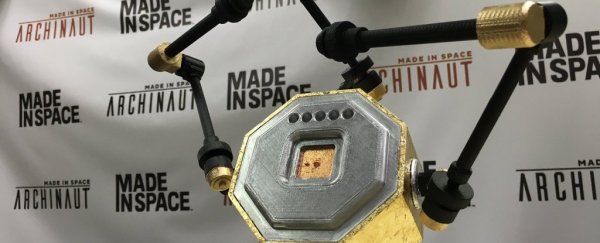One manufacturing company just made history by successfully using a special 3D printer in extreme, space-like conditions.
The team printed polymer alloy parts in a super-high vacuum, and hope their new tech will allow the design and manufacture of much more ambitious spacecraft and space-based telescopes.
"This is an important milestone, because it means that we can now adaptively and on demand manufacture things in space," Andrew Rush, CEO of Made in Space, told Scientific American.
Made In Space, the American company behind this project called Archinaut, was founded in 2010 as a space-based manufacturing company specialising in 3D printers for use in the microgravity of space.
The company has already demonstrated the ability to print 3D parts in a zero-g environment.
In 2010 it printed a range of structures on the International Space Station, including tools the astronauts could make on demand so they don't have to wait for the next payload.
Right now there are two 3D printers on the ISS, but neither printer has ever left the safety of the station and experienced the extreme vacuum or temperature fluctuations of the silent void that is space.
To simulate the conditions found outside a spacecraft, the team performed a 24-day Earth-based test inside a thermal vacuum chamber. They were able to print polymer alloy beams up to 85 centimetres long.
This is where it gets really exciting – the 3D printer is only one part of a much more ambitious project.
Archinaut combines 3D printing technology with robotic arms that are used to assemble structures that the printer spits out. The team believe that will change the way we explore space.
"We do believe that in-space robotic manufacturing and assembly is going to revolutionise the way we design and deploy and operate systems in space," said Steve Jurczyk, the head of NASA's Space Technology Mission Directorate, at a press conference.
In the future, the company hopes large structures will be able to be built in space, allowing for the construction of much larger space telescopes. Currently, they need to be able to fit inside the nose cone of a vehicle launched from Earth.
For example, engineers will channel their inner origami master to contort 80 separate parts of the James Webb telescope into a nose cone, taking a total of 80 missions costing US$8.8 billion.
But NASA wants to build even bigger telescopes, ones at least 12 metres wide, to hunt for signs of life in exoplanet atmospheres and perform other ambitious observations.
"That mission is just not doable right now, given the current launch vehicles and trying to fold things up and fit them in a launch vehicle shroud, in a single launch," Jurczyk told Space.com. "It would take multiple launches of partially assembled systems, which would be expensive."
The next stage of the project is to test the combination of printers and robotic arms and fly a demonstration mission in earth's orbit.
If we are lucky, we'll see the technology deployed into space by the mid 2020s.
"I think operational systems in that time frame are very achievable," Rush told Space.com.
